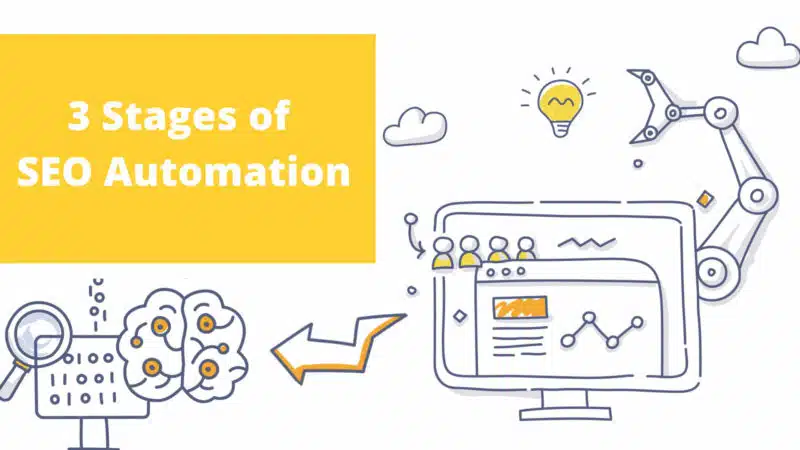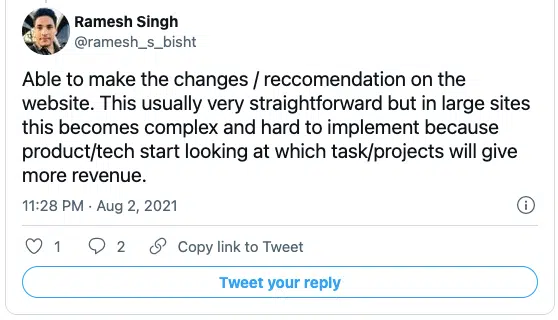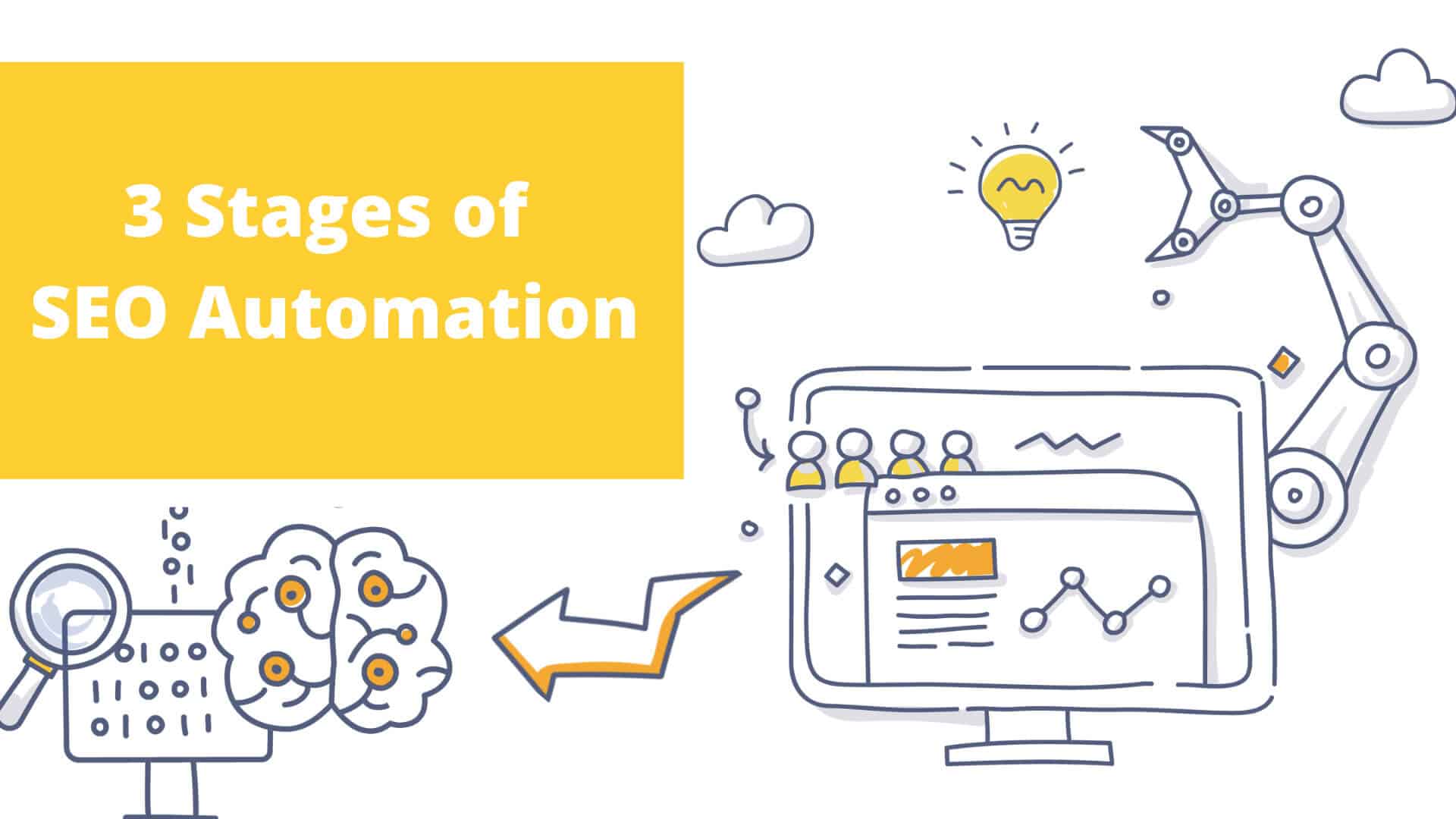
The SEO industry has a large problem: an overwhelming lack of resources and available talent.
This becomes more apparent at the enterprise level, where data sets are vast, dense, and complex, making it difficult not only to make sense of the data but to act on it.
Not to mention the numerous SEO tools are advanced and great at pointing out issues to SEOs, but lack the ability to actually “do SEO.”
Automating SEO allows marketers to reduce the time from data to insights to action, so they can implement faster and see results.
The number one challenge we hear from enterprise SEOs is getting things done.
In fact, a study by Distilled in 2016 found that the majority of SEOs didn’t see their recommendations implemented for “close to 6 months after they were requested.”
Misaligned priorities can make it difficult to implement even the smallest of changes — a simple tweak to the metadata can take months to deploy to production!
Ramesh Singh, Head of SEO at Great Learning, echoes this point in response to the question, “What SEO function/task do you most wish you could do faster and at bigger scale than you can now?”


All the while, Google continuously becomes more intelligent, using machine learning and AI to serve users the most relevant information in the most effective way. The SERPs are more complex than ever, with Google entities becoming the direct competition.
There’s too much data to act on for any human agent alone. Automation, however, works around the clock and can generate insights that would otherwise take hours to reach.
SEOs naturally face human limitations in their ability to sort through data and act on insights at the level that’s required today — AI and machine learning can fill the gaps and accelerate execution.
In order to reap the benefits of automation, it’s important to start with the basics before moving on to automated insights, and lastly, automated execution.
Automation has changed and evolved over the years, so let’s break down what SEO automation looked like in the past compared to its current state.
#1. Beginner: Data collection
Beginner-level automation starts with pulling together data sets and learning how to drive the car, so to speak.
Data aggregation and collection is an important step in your maturity in SEO. If you are still manually downloading and aggregating data in an attempt to draw insights, there are easier ways to do this.
It includes things like:
- Rank tracking
- Reporting and dashboards
- Backlinks
- Site crawl data
If you are new to automation, you need to start here! Automation compounds itself, so you can’t benefit from it unless you start with the basics.
The good news is that data collection and aggregation is a commodity. Hundreds of SEO tools offer this for a fraction of the cost it once was.
Enterprise organizations, however, have extra considerations to be mindful of security, stability, reliability, scale, and SLAs should all be taken into account when working with automation tools.
An SEO platform like seoClarity consolidates data from rankings, links, and site crawl data for your site and any competitor and automates reporting at scale with enterprise security.
#2. Intermediate: Automated insights
As automation progresses, SEOs can prioritize their time where it counts and let the technology surface site-specific, actionable insights for them.
This begins with alerts based on AI: receive a notification if the AI detects a major rank change or if a critical page element is modified or deleted.
In this case, automation works as a member of your team, continuously monitoring thousands of pages, so you don’t have to.
Once alerts are automated, SEOs can turn their attention to the advanced and custom insights that are delivered from AI. These insights help to identify opportunities and issues so you can prioritize strategy and execution.
Some examples of this include recommendations and actions within:
- Technical audits
- Content analysis
- Log-file analysis
- Backlink analysis (identify link partners, quality backlinks, toxic links)
- Keyword research (analyze competitors, identify keyword patterns and topics)
- Page and rank change alerts
Marketers need to understand that the sophistication of automation varies greatly in what SEO software can provide.
Advanced AI and machine learning are required to surface and customize those insights specifically based on your site’s ranking, crawl, and link data. Not just generic and basic on-page SEO that most tools provide.
Even Lily Ray, a respected SEO consultant, and influencer, says here:


Actionable Insights from seoClarity analyzes data in real-time to reveal custom, site-specific opportunities and issues for content, page speed, indexability, schema, internal links, and more.
These insights are based on your site’s ranking, crawl, and link data, so the technology actually analyzes your site as if it were a member of your in-house SEO team.
Marketers need insights that are personalized to their site and data — if the cookie-cutter approach worked, everyone would rank on page one.
#3. Advanced: Scaling execution
The next step in SEO automation is execution, implementation, and testing.
Everyone agrees the biggest challenge in enterprise SEO is the speed of execution and implementation at scale!
Whether it’s waiting months for simple updates to be implemented or working on a forecast to get a project prioritized, it slows down what we KNOW should be implemented all while Google (and the competition) speed ahead.
JC Connington, head of SEO at Cancer Research UK, comments about implementing schema at scale within a large site.


The bottom line is results don’t happen unless Google can see the changes on your site.
The latest development in automation empowers SEO teams to address the roadblocks that stand in their way and deploy changes to a site in real-time without the need for developers, UX teams, and other stakeholders.
Most companies and SEO teams haven’t implemented this level of automation in SEO … yet.
Why? Maybe it’s not accessible, or it seems too complicated.
Even though it’s the top complaint and roadblock we hear from SEO teams, companies struggle to scale execution.
You can start your journey to scale SEO execution today with seoClarity.
Be among the first to leverage advanced automation in SEO with a machine that continuously updates your site in real-time. Sign up to be a part of the beta launch.



